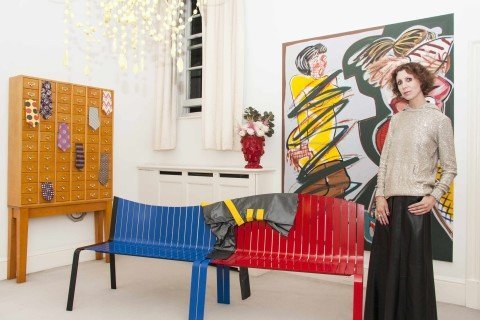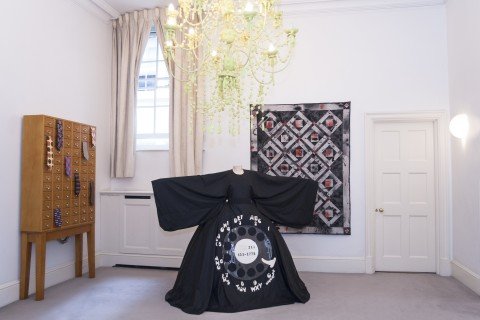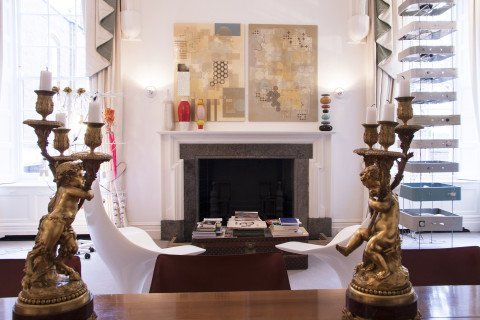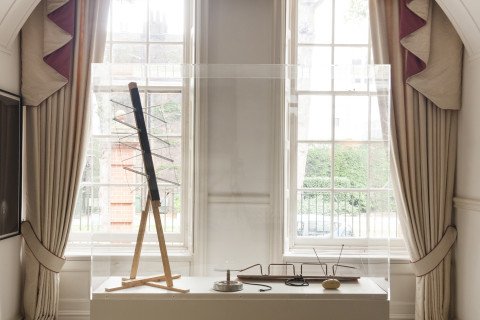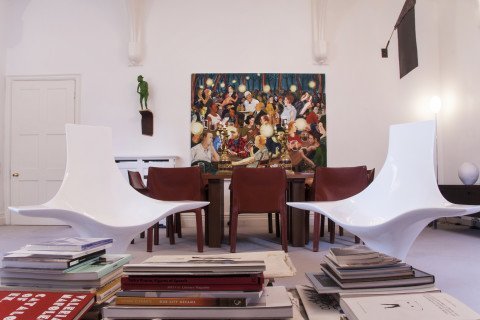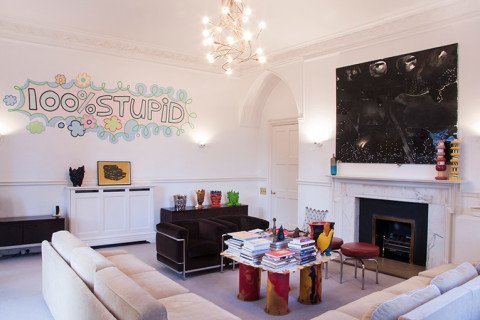In dialogue with Valeria Napoleone and the bright side of emerging art
- Valeria Napoleone.
- Valeria Napoleone Collection, Entrance.
- Valeria Napoleone Collection, Living room
- Valeria Napoleone Collection: Amalia Pica, Vitrine 1 (Unintentional Monument No 10,11,12 and 13), 2010.
- Valeria Napoleone Collection, Living room.
- Valeria Napoleone Collection, Dining room.
- Valeria Napoleone Collection, Front room.
If you are worried about the future of young artists and you need to find relief from the aggressive strategies adopted by the new generation of dealers, get inspired by our interview with Valeria Napoleone. Her experience of collecting proves that in order to succeed in this occupation you have to be an independent thinker, someone who buys according to the collection’s focus, even when it takes time or is against the consensus view.
Why have you started collecting?
In 1997 I was living in New York. I graduated from NYU in journalism, and then I did a Masters degree in “Art Gallery Administration” at the Fashion Institute of Technology. After two years at the FIT I started collecting. These two years were pivotal for me in terms of meeting people within the contemporary art world and in understanding its functions. In some way, I felt ready to start my journey.
What have you learned in these twenty years?
I’ve learned how to know myself as a collector, what reactions I am looking for in front of an artwork that I would like to have in my collection.
So, what do you want?
It’s learning what moves me. I’ve learned my taste, and it takes a while. I’ve learned that the art world is where I belong and where I feel totally comfortable. I’ve learned that half of what I do is about patronage and philanthropy and how important artists are for me. I’ve also learned to engage the way I want to.
For certain collectors, the sense of their collection comes along the way, some time after they have started it. Is this your case or did you know it from the beginning?
Probably I knew it since the start, but those two years at the FIT have been extremely important for me as I met curators, gallerists, dealers and artists. There I had a 360° vision of how the art system works and who does what. It was possibly the most thrilling time of my life, when I learned about contemporary art, and when I tasted the excitement that I felt around artists.
Which is the first piece you bought?
The first piece I bought was by a woman artist. Since the very beginning I told myself that my collection would be focused on female artists. I also told myself that I was going to collect and that it was not just a random purchase, because of an infatuation. It is a commitment on the long term, and I knew that.
If we were to compare your path as a collector to the first twenty years of a human being, we would have a lot of important stages, from the beginning of nursery, to school, the first love, then probably marriage and so on. Could you pinned down some stages in your collecting maybe through some works that have been particularly significant to you?
Williamsburg was the place where I spent the first moments of my life as a collector, visiting artists’ studios and often going to galleries, including Pierogi 2000. Those were really my first steps and I learned since then how important it was to engage with the artists. In this first phase, I met Ghada Amer, a person that deeply affected me. We grew together, myself as a collector and she as an artist, and we are now close friend. That was when I was toddler. My coming to London taught me that I could navigate any reality, and it is where I found my family, and indeed my way.
And then?
I grew up here, but I don’t feel I’m a grown-up yet. I still feel like a little kid, there are still many things that I want to do and hopefully I will do… at the moment I’m probably in my early ‘20s as a collector. In London I’ve also become able to grow up in understanding which projects are for me and which are not; I can sense it. It does come very naturally.
Were you looking at any specific gallery at that time?
The very first place I connected with in London was the South London Gallery. I’ve been supporting them since the second year I arrived. Margot Heller is an incredible person.
An early love as well was Studio Voltaire. One (if not the one) of the most respected not-for-profit gallery in London I have been involved with for the past 9+ years. An incredible place of experimentation and freedom for the artists. It has become one of the most important ongoing project in my life. I am the Chair of the Development Committee.
Is London your base now?
It is. But I do see my future between London and New York. I will be traveling back and forth between the two cities more and more often.
Not Los Angeles?
No. New York is a natural place for me to go back to as I lived there many years and I do feel I am a New Yorker. I’m involved with NYU, my university, as one of the President’s Global Councils. There are few other things that I am working on now that will take me there and engage on a long-term…until my ‘80s.
So, this is a wedding, isn’t it?
Yes It is. I don’t think you can build a collection in just a few years and buying occasionally. I am very ambitious for the collection, it’s important to me and hopefully it will mean something to other people too. The most precious element you have is time and if you can dedicate decades to a collection with passion and dedication, then it is really what makes it special.
You said that the first two years you learned how this art world functions. Does it work in the same way everywhere?
I think more or less so. There are some shades between white and black. Europe is softer and I like it. I’m a European collector, not in what I do but in the way I function. I like time and I need it to make decisions. As much as I love New York, I think it’s too fast and furious. I think long and deep about an artist, I take my time, I discuss the work and do studio visits, then I follow the artist’s practice for a while. People need to be patient with me…
Do you have a synthetic formula to explain how the art world functions?
Not really.
What do you like the most about the art world and what, instead, you don’t?
I think this is a big subject. There are so many things that work fantastically. I love the art world because for me it means being surrounded by talents. It is also a personal journey of discovery. You don’t know what is around the corner and this is the most fascinating factor for me. It is a journey that I do with a lot of people around me. Indeed, the most beautiful part of it is to connect with people, with curators, artists, gallerists, museums’ directors and create projects that hopefully are also meaningful to others. I like the informality of the art world, or at least of my art world… because there are many art worlds. The honesty of so many around me (especially the artists), their love for who I am and what I do, and their support are the keys. I’m loved and I’m supported by the people who are important to me; and this is priceless. What I don’t engage with is the speculation in the art market. I don’t connect to the idea of time as a liability. People seem scared to give artists time to develop and that’s frightening to me because talent needs time to grow, to make mistakes, to experiment and to pass through phases.
It is indeed a matter of fact that the distribution of info through social networks has possibly made the price the most important factor when considering an artwork, disregarding to all the other infos which should possibly be more relevant. What is your view on this?
There is a lot in the art world that shouldn’t be there and there are many artists, who shouldn’t be artists. Nowadays there is so much attention on contemporary art, for many different reasons and many people are starting collecting maybe because it’s cool, because it’s a life-style, or because their friends do it too. There are many more people coming into the contemporary art world, including artists. This doesn’t necessarily mean that they will last, especially artists. I think that there is a lot of distraction in contemporary art today, for everyone involved (artists, curators and gallerists). If you don’t have integrity you will make a lot of mistakes… or at least what according to me are mistakes. If you sustain your work with integrity, only this will last the proof of time. There are a lot of people doing things for the short term.
Within this group of people, don’t you miss critics, that is independent voices?
I like to be exposed to healthy dialogue, and analysis and criticism are part of it. I constantly think at and question what I do and how I do it. I welcome exchanges of thoughts from people I respect, positive criticism making me more aware and analytical on my journey. I think it is healthy to have some powerful voices who in a way are beyond any interest. Actually these little moment of discomfort make you think further, reconsider things you do and the way you do them. Very healthy.
Can you pinpoint some names or aren’t there any at the moment?
There are quite a few strong voices, curators and art writers. However, as in the mode of the contemporary art world now, everything goes. There is too much of everything. The question to me is, would you say curators/writers are seduced by fashions/trends, prices at auctions and act accordingly in order to make popular shows or write popular pieces? Definitely quite a few do.
The last two years have been extraordinary, that is out of the ordinary in terms of auctions and prices. Do you think things will change this year?
I’m not really up to speed on what’s happening with the auction houses but again, I think it’s only a matter of time. In five, ten or twenty years, the vast majority of these artists will not be around. I have many friends concerned, especially gallerists as they see their galleries empty. People don’t go to galleries any more. They tend to focus just on buying mainly at auctions and art fairs. I’m talking about the large new public entering the contemporary art market, not the few devoted collectors. But in the end it is where the new money actually comes from. Auction houses are expanding their domain and appropriating other roles other than their traditional one. It is an easy solution to new art buyers, a one-stop shopping. I’m concern that people don’t see artworks anymore in the right context, of a gallery/art space show. Also, dealers tend to do too many fairs, instead of focusing on a few good ones. And they ask artists to stretch their production. I pay a lot of attention to where the work in my collection comes from. I’m very careful that these works are relevant for the artist, and that are produced in the ideal context, that of a gallery or museum show. When I buy works at an artfair I buy only from gallerists I know and respect, and works by artists I already know. I would like to see people back in the galleries and navigating the artworld in a healthy and balanced manner.
Moreover, it’s a matter of fact that during an art fair you don’t really have enough time to absorb the work of art.
I do not function that way. Only if I know the gallerist, and the artist and I find a real gem, then I can act pretty quickly. Otherwise, I step back and let it go. I can’t make a decision in half an hour or an hour, not even in one day. Sometimes it can take one, two or three years. It’s a journey and I don’t want to be under pressure. The way I behave is actually opposite to the pace the market is going right now. The market is moving very fast and I slow down because I need time to digest my food. I need time to understand the work, the artist and their practice. I need to connect to the work and feel that the work is for me. To do so I need time to dig myself into understanding what is going on conceptually. I like to have a strong sense of past, present and future in regards to an artist’s practice. So I need time to go through the works produced in the past, and being produced in the present, and I often wait for the next show to come up. This dynamic puts me in the slow lane.
Then it’s a journey for a long distant runner…
It’s a fantastic journey and I can’t wait to see what’s coming up next. It’s a journey of relationship and growth, of supporting the people I believe in and indeed been supported by them. It is a shame so many people do not explore this great opportunity that collecting contemporary art offers. This is what made me want to be involved in contemporary art in the first place and what continuously drives me. It is such a plus compared to collecting antiques, where everything starts and finishes with the object. On the other hand, I like to see my collection as more than the some of its parts. I want to create something that is meaningful as a whole, and not just a bunch of objects or names, and that is also a reflection of a journey.
Is being a collector a profession?
Yes, it is a profession I love. I generally say I’m curating my life life out of different creative projects and it’s the best job I could have ever dreamed of.
So do you dedicate all your time to it?
Yes, it is a full time job.
And this depends just marginally on your financial means, doesn’t it?
Yes indeed. Every year I have a budget that I set. Sometimes it’s bigger, sometimes smaller, sometimes I don’t have it and it goes along with my life. When people tell me that you need a lot of money to become a collector I reply that it’s isn’t true. You have to have a lot of passion and you have to be constantly focused. It’s not about how much money you invest in it, it’s more about having a vision and following it.
Is there any model of collecting that inspires you?
Years ago, when I started navigating the art world I was in Berlin and I went to visit the Hoffmann Collection and I met them. This was really inspiring. I felt in what they were doing a powerful sense of mission , of personal dedication and taste. It wasn’t a collection of names, it was a vision. They were deeply committed, not buying with their ears but with their eyes. Moreover, they were not talking about mistakes. People keep asking me which are the mistakes I’ve made. Being a collector is a journey; there are no mistakes if you buy what you love.
Let us suggest you a scheme for the making of the value of an artwork: 30% gallerist, 30% artist, 30% collector.
That depends… in my ideal world it would be 70% artist, 30% gallerist. Good collectors will came in a second stage.
So collector doesn’t have any role at all…
What I am saying is that many great artists are struggling, and some of them because of no support from good gallerists, or any gallerists at all. The support of a good gallerist is powerful and indeed essential to artists, to guide and support them through their career. Good collectors will come. Good, dedicated gallerists are needed, and are much more important on the making of a great artist than it is now recognized.
In terms of creativity, which are the best cities for an artist to be?
I think Berlin is still a center for artist.
How about Paris?
No, I don’t see Paris, and neither Milan. Los Angeles is also a Mecca for artists to move to, larger and cheaper studios and a vivacious art world.
Do you also collect antiques?
No, I don’t. I grew up with my parents buying Italian works from XVI and XVII century. I was exposed to art and that helped me to train my eye to beauty. However, the discovery of contemporary art and the reality of living artists was turning point in my life. So different from buying antiques where everything starts and ends with the object.
Have you never been attracted by antiques then?
No, I never did. However, the antique teaches you to look at and for things that last.
April 21, 2015

